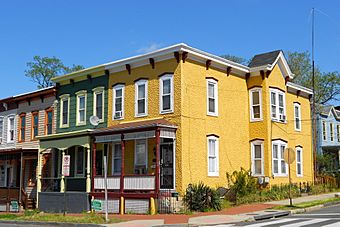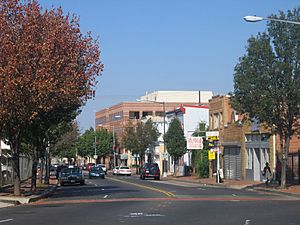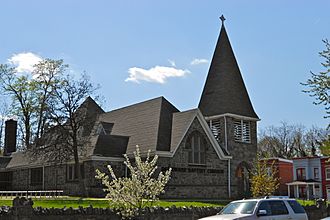Anacostia Historic District facts for kids
|
Anacostia Historic District
|
|

Houses at 13th and W Streets
|
|
| Lua error in Module:Location_map at line 420: attempt to index field 'wikibase' (a nil value). | |
| Location | Roughly bounded by Good Hope Rd., 16th St., Mapleview, Washington, District of Columbia |
|---|---|
| Area | 83 acres (34 ha) |
| Built | 1854 |
| Architectural style | Italianate, Cottage style |
| NRHP reference No. | 78003050 |
Quick facts for kids Significant dates |
|
| Added to NRHP | October 11, 1978 |
The Anacostia Historic District is a special area in Washington, D.C.. It includes about 20 city blocks and 550 buildings. These buildings were mostly built between 1854 and 1930. This district was added to the National Register of Historic Places in 1978. It's known for its unique look. You won't find another place in Washington, D.C., with so many small, old homes. These homes were built for working families in the late 1800s and early 1900s.
The historic district is generally located around:
- Martin Luther King, Jr. Avenue SE
- Good Hope Road SE
- Fendall Street SE
- V Street SE
- 15th Street SE (near the Frederick Douglass National Historic Site)
- High Street SE
- Maple View Place SE
Most buildings in the Anacostia Historic District are two stories tall. They are made of brick and wood. The houses often show styles like Italianate and Cottage. Some are also in the Washington Row House style. A few homes are in the Queen Anne style. Older homes tend to be Cottage style. Italianate homes became popular after 1870. Many houses here have big lawns and porches that wrap around the house.
Contents
Anacostia's Rich History
Early Settlers and Names
The first people to live in this area were the Nacotchtank Native Americans. They lived and fished along the Anacostia River. Captain John Smith was the first European to visit in 1612. He called the river "Nacotchtank." Later, explorers Henry Fleet and Leonard Calvert gave the area its current name, "Anacostine." This name means "trading village." The Nacochtank villages were busy trading spots. Sadly, war and disease greatly reduced the Nacochtank population. By the late 1600s, they joined other local tribes.
European settlers first arrived in 1662. In 1663, Lord Baltimore gave most of the land on the Anacostia River's south bank to George Thompson. An "Anacostia Fort" was built on the hills in the 1700s.
Becoming Part of D.C.
The area became part of Washington, D.C. in 1791. Congress decided to create a new national capital here. George Washington chose this spot. In 1795, a land buyer named James Greenleaf bought most of what is now the Anacostia Historic District. Even though he later faced money problems, a few homes were built. Later, William Marbury, a wealthy merchant, bought much of this land.
The first real town in the Anacostia Historic District began in 1820. The Washington Navy Yard was growing. Many workers needed homes. In 1818, the "Upper Navy Yard Bridge" was built. This bridge made it easier to reach Anacostia. It helped new homes be built on the eastern side of the river.
In 1820, the town of Good Hope, D.C., was started. It was near where Good Hope Road SE is today. Businesses began to open along Good Hope Road. This formed the Anacostia Business District. A post office was set up and called Good Hope Station. In 1849, its name changed to Anacostia.
The Birth of Uniontown
In 1854, three developers bought 240 acres of land in Anacostia. They divided it into lots for houses. They named the new community Uniontown. It was Washington's first "suburban" area. The main street was 14th Street SE. It had a market and a wide boulevard.
The first house in Uniontown was a two-story brick building. A grocery store also opened. In 1855, one of the developers built "Cedar Hill." This was a large house on Jefferson Street. Dr. Arthur Christie, a rich Englishman, bought 50 acres and named his estate Fairlawn.
The American Civil War (1861-1865) brought many changes. After a battle, leaders realized Washington, D.C., needed better defenses. They built forts around the city. Fort Stanton was one of the first. It was built in 1861. A military road was built to connect the fort to the river.
Uniontown was officially named in 1865. But because there was another Uniontown in Pennsylvania, the name changed back to Anacostia in 1866. Fort Stanton closed in 1866.
After the war, the land company that created Uniontown faced financial trouble. They had to sell Cedar Hill. In 1877, Frederick Douglass, a famous abolitionist, bought the mansion. He bought it even though there was a rule against selling property to people of African descent. By 1880, about 15% of Uniontown's residents were African American.
Growing and Changing
Several new neighborhoods were built in the late 1800s. These included Griswold's, Green's, and Avalon. They kept the same building styles as the original Uniontown.
The area also saw many improvements. Horse-drawn streetcar service arrived in 1875. Electric streetcars came in 1895. Churches like St. Teresa's Catholic Church (1879) and Emanuel Episcopal Church (1891) were built. A police station was set up in 1901. The Ketcham School was built in 1907. Water and sewer services were added between 1904 and 1920. In 1908, street names in Anacostia were changed to match those in Washington, D.C.
For a long time, Anacostia and other nearby communities like Barry Farm and Congress Heights were separate. Much of the land between them was undeveloped. This changed during World War II. Many federal workers moved to the capital, creating a huge need for housing. This led to a lot of building and connected these areas.
In the 1960s and 1970s, many people moved to the suburbs. The Anacostia neighborhood changed a lot. By 1970, most residents were African American. The neighborhood faced challenges, and many businesses left.
Protecting the Historic District
The Washington Metro's Green Line was planned to go through Anacostia. People worried it would harm the historic area. So, the Metro station was moved to a different spot.
The Anacostia Historic District was added to the National Register of Historic Places in 1978. This helps protect its unique character. Efforts have been made to improve the area. Being a historic district has helped prevent certain businesses from moving in.
In 1992, the city started replacing concrete sidewalks with red brick. This was to make them look like they did originally. In 2002, a law was passed to help homeowners. It allowed them to get a tax credit for renovating their homes. Five years later, the D.C. Historic Preservation Office gave grants to residents. These grants helped them restore and fix up their homes. In 2008, the grant program's budget was increased. These efforts help keep the Anacostia Historic District special for future generations.
Images for kids








